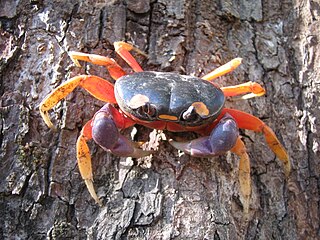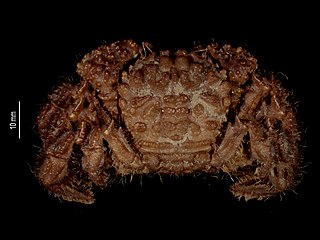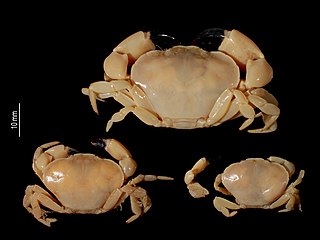
Mictyris is a genus of brightly coloured crabs, placed in its own taxonomical family, the Mictyridae. It inhabits the central Indo-West Pacific region. These crabs congregate on mud flats or beaches in groups of a few thousand, and filter sand or mud for microscopic organisms. They congregate during low tide, and bury themselves in the sand during high tide or whenever they are threatened. This is done in wet sand, and they dig in a corkscrew pattern, leaving many small round pellets of sand behind them.

Tuerkayana hirtipes is a species of terrestrial crab.

The stalk-eyed mud crab is a marine large-eyed crab of the family Macrophthalmidae, endemic to New Zealand including Campbell Island. It grows to around 30 millimetres (1.2 in) shell width. It is either the only species in the subgenus Hemiplax and the most basal species in the genus Macrophthalmus, or the only species in the sister genus Hemiplax.

Discoplax is a genus of terrestrial crabs. It is very closely related to the genera Cardisoma and Tuerkayana.

The Gecarcinidae, the land crabs, are a family of true crabs that are adapted for terrestrial existence. Similar to all other crabs, land crabs possess a series of gills. In addition, the part of the carapace covering the gills is inflated and equipped with blood vessels. These organs extract oxygen from the air, analogous to the vertebrate lungs. Adult land crabs are terrestrial, but visit the sea periodically, where they breed and their larvae develop. Land crabs are tropical omnivores which sometimes cause considerable damage to crops. Most land crabs have one of their claws larger than the other.

Cardisoma is a genus of large land crabs. Three species formerly placed in this genus are now placed in Discoplax. The four species that remain in Cardisoma are found in warm coastal regions where they live in burrows. Young individuals are often very colourful with a purple-blue carapace and orange-red legs, but as they grow older the colours tend to fade, and females may be duller than males. Although less extreme than in fiddler crabs, one claw is usually considerably larger than the other. They are omnivores, but primarily feed on plant material.

Pseudothelphusidae is a family of freshwater crabs found chiefly in mountain streams in the Neotropics. They are believed to have originated in the Greater Antilles and then crossed to Central America via a Pliocene land bridge. Some species of this family are troglobitic.

Gecarcinus is the type genus of the land crab family Gecarcinidae. They are found in warmer coastal regions of the Americas, including islands in the Caribbean. Four species from oceanic islands were formerly included in Gecarcinus as the subgenus Johngarthia, but are now treated as a separate genus, Johngarthia. While all members of this genus are largely terrestrial, they have to return to the ocean to breed. They are often colourful, with reddish, orange, purple, yellowish, whitish, or blackish being the dominating hues. This has resulted in some species, notably G. quadratus and G. lateralis, gaining a level of popularity in the pet trade.

Johngarthia is a genus of crabs in the land crab family Gecarcinidae, formerly included in the genus Gecarcinus, and containing six species. The genus bears the name of John S. Garth, a 20th century naturalist who specialized in crabs and other arthropods.

Epigrapsus is genus of terrestrial crabs. The two species are omnivores.

Vultocinus anfractus is a species of crab, the only species in the family Vultocinidae. It has been found around the Philippines, Vanuatu and New Caledonia, and lives on driftwood. Its discovery forced a reappraisal of the relationships within the superfamily Goneplacoidea, and to the recognition of Mathildellidae, Conleyidae and Progeryonidae as separate families.
Tanaocheles is a genus of crabs, the only genus in the family Tanaocheleidae. It contains two species, T. bidentata and T. stenochilus. The two species were formerly placed in different families, and they were only shown to be related, and placed in a new subfamily, in 2000.

Trapeziidae is a family of crabs, commonly known as coral crabs. All the species in the family are found in a close symbiosis with cnidarians. They are found across the Indo-Pacific, and can best be identified to the species level by the colour patterns they display. Members of the family Tetraliidae were previously included in the Trapeziidae, but the similarities between the taxa is the result of convergent evolution.
Villalobosius is a genus of crabs in the family Pseudothelphusidae, containing a single species, Villalobosius lopezformenti. It lives in the northern part of the state of Oaxaca, Mexico, on the Isthmus of Tehuantepec, and is adapted to a troglobitic lifestyle.

Karstarma is a genus of karst-dwelling crabs formerly included in Sesarmoides.

Euryxanthops is a genus of crabs in the family Xanthidae. It was originally established in 1983 by Garth & Kim to contain three species of deep-water crabs from Japan and the Philippines - Euryxanthops dorsiconvexus, Euryxanthops flexidentatus and Euryxanthops orientalis. Since then, several more species of this genus have been identified and described, and Euryxanthops currently contains:
Danièle Guinot is a French biologist, an emeritus professor at the Muséum national d'histoire naturelle in France, known for her research on crabs.
Conleyus defodio is a species of crab, the only species in the genus Conleyus and the family Conleyidae. It lives in rubble beds in Guam, and is named after the collector Harry T. Conley.

Nanhaipotamon is a genus of freshwater crabs, in the subfamily Potamiscinae, found in southern China and Taiwan. As of 2018, 18 species have been described. The genus is named after the South China Sea, for it occurs mostly in coastal areas. The genus was first described by R. Bott in 1968 as Isolapotamon (Nanhaipotamon), i.e., a subgenus of Isolapotamon.

Tubuca dussumieri, is a species of fiddler crab that is found in the western and south pacific including New Caledonia, Indonesia, Malaysia, Taiwan, Japan, north eastern Australia


















